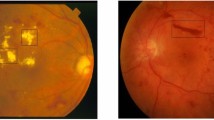Abstract
Medical image classification system is widely used by the radiologists to segment the medical images into meaningful regions. Glaucoma is an optic neuropathy defined by characteristic damage to the optic nerve and accompanying visual field deficits. Early diagnosis and treatment are critical to prevent irreversible vision loss and ultimate blindness. Automatic detection of diabetic retinopathy in retinal image is vital as it delivers data about unusual tissues which is essential for planning treatment. Automating, this method is challenging due to the high variabiity in the appearance of tissue among dissimilar patients and in many circumstances, the comparison between abnormal and normal tissue. This paper presents a new methodology and a computerized diagnostic system for diabetic retinopathy. In this article, adaptive histogram equalization is used to convert colour images to gray scale images followed by significant features are selected using hybrid colour and structure descriptor (HCSD). Finally, various classifiers are used for classification of images into normal and glaucomatous classes. The overall classification accuracy of HCSD with Hybrid Radial Basis Kernel based Support vector Machine (HRKSVM) is 97.55%, HCSD with Support vector Machine (SVM) is 94.77% and HCSD with Hybrid Kernel Support Vector Machine (HKSVM) is 95.71%.







Similar content being viewed by others
References
Caselles V, Catte F, Coll T, Dibos F (1993) A geometric model for active contours in image processing. Numer Math 66(1):1–31
Chan T, Vese L (2001) Active contours without edges. IEEE Trans Image Process 10(2):266–277
Cremers D (2003) A multiphase level set framework for variation motion segmentation. In Proc Scale Space Meth Comput Vis, Isle of Skye, U.K. pp 599–614
Dhanasekaran R, Jayachandran A (2014) Severity analysis of brain tumor in MRI images uses modified multi-texton structure descriptor and kernel- SVM. Arab J Sci Eng 39(10):7073–7086
Huang D, Swanson EA, Lin CP, Schuman JS, Stinson WG, Change W, Hee MR, Flotte T, Gregory K, Puliafito CA, Fujimoto JG (1991) Optical coherence tomography. Science 254:1778–1781
Jayachandran A, Dhanasekaran R (2013) Brain tumor detection using fuzzy support vector machine classification based on a texton co-occurrence matrix. J Imaging Sci Technol 57(1):10507-1-10507-7(7)
Jayachandran A, Dhanasekaran R (2017) Multi class brain tumor classification of MRI images using hybrid structure descriptor and fuzzy logic based RBF kernel SVM. Iran J Fuzzy Syst 14(3):41–54
Jurie F, Triggs B (2005) Creating efficient codebooks for visual recognition, in: Proceedings of the Tenth IEEE International Conference on Computer Vision, Los Alamitos, 17th-21st October 2005, vol. 1, IEEE, pp 604–610
Juuti-Uusitalo K, Delporte C, Grégoire F, Perret J, Huhtala H, Savolainen V et al (2013) Aquaporin expressionand function in human pluripotent stem cell-derived retinal pigmented epithelial cells. Invest Ophthalmol Vis Sci 54:3510–3519
Kharmegasundaraj G, Jayachandran A (2016) Abnormality segmentation and classification of multi model brain tumor in MR images using fuzzy based hybrid kernel SVM. Int J Fuzzy Syst 17(3):434–443
Kimmel R, Amir A, Bruckstein AM (1995) Finding shortest paths on surfaces using level set propagation. IEEE Trans Pattern Anal Mach Intell 17(6):635–640
Kolar R, Jan J (2008) Detection of glaucomatous eye via color fundus images using fractal dimensions. Radio Eng 17(3):109–114
Kramer G, Schierz C (2016) Color discrimination subject to illuminant and color transition. Color Res Appl 41(5):457–467
Kumar T, Verma K (2010) A theory based on conversion of RGB image to gray image. Int J Comput Appl 7(2):7–10
Kumar M, Pachori RB, Acharya UR (2017) Characterization of coronary artery disease using flexible analytic wavelet transform applied on ECG signals. Biomed Signal Process Control 31:301–308
Larose DT (2004) Discovering knowledge in data: an introduction to data mining, chapter 5: KNN, New Jersey Willey Interscience, USA, pp 90–106
Leung T, Malik J (2001) Representing and recognizing the visual appearance of materials using three-dimensional textons. Int J Comput Vis 43(1):29–44
Li C, Huang R, Ding Z, Gatenby JC, Metaxas DN (2011) A level set method for image segmentation in the presence of intensity inhomogeneities with application to MRI. IEEE Trans Image Process 20:7
Li Y, Zhang Y, Geng A, Cao L, Chen J (2016) Infrared image enhancement based on atmospheric scattering model and histogram equalization. Opt Laser Technol 83:99–107
Maheshwari S, Pachori RB, Acharya UR (2016) Automated diagnosis of glaucoma using empirical wavelet transform and correntropy features extracted from fundus images. IEEE J Biomed Health Inf 21(3):803–813
Malladi R, Sethian JA, Vemuri BC (1995) Shape modeling with front propagation: a level set approach. IEEE Trans Pattern Anal Mach Intell 17(2):158–175
Martõnez-Rojas M, Marõn N, Vila MA (2015) An approach for the automatic classification of work descriptions in construction projects. Comput Aided Civ Inf Eng 30(12):919–934
Mumford DB, Shah J (1989) Optimal approximation by piecewise smooth functions and associated variational problems. Commun Pure Appl Math 42:577685
Osher S, Fedkiw RP (2001) Level set methods: an overview and some recent results. J Comput Phys 169:463–502
Osher S, Sethian JA (1988) Fronts propagating with curvature dependent speed: algorithms based on Hamilton Jacobi formulation. J Comput Phys 79(1):12–49
Paragios N, Deriche R (2000) Geodesic active contours and level sets for detection and tracking of moving objects. IEEE Trans Pattern Anal Mach Intell 22(3):266–280
Schwartz SD, Hubschman J-P, Heilwell G, Franco-Cardenas V, Pan CK, Ostrick RM et al (2012) Embryonicstem cell trials for macular degeneration: a preliminary report. Lancet 379:713–720
Sethian JA (2001) Evolution, implementation, and application of level set and fast marching methods for advancing fronts. J Comput Phys 169:503–555
Author information
Authors and Affiliations
Corresponding author
Additional information
Publisher’s Note
Springer Nature remains neutral with regard to jurisdictional claims in published maps and institutional affiliations.
Rights and permissions
About this article
Cite this article
Stalin David, D., Jayachandran, A. A new expert system based on hybrid colour and structure descriptor and machine learning algorithms for early glaucoma diagnosis. Multimed Tools Appl 79, 5213–5224 (2020). https://doi.org/10.1007/s11042-018-6265-1
Received:
Revised:
Accepted:
Published:
Issue Date:
DOI: https://doi.org/10.1007/s11042-018-6265-1




